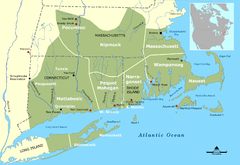Massachusetts
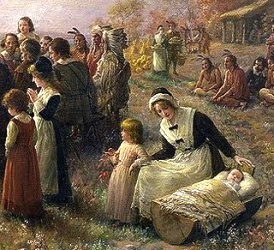
Increase Mather
Our National History Day Group Documentary on Increase Mather. Our Documentary is formerly titled as “The Political Priest: Increase Mather.” Mather is a pivotal historical figure from Massachusetts at the turn of the 17th Century. The Documentary conveys his legacy.
 Timeline of Massachusetts: 1400’s
Timeline of Massachusetts: 1400’s
- (1498) English explorer, John Cabot, sailed along Massachusetts coast
1600’s
- (1602) Bartholomew Gosnold explored coast; named Cape Cod due to codfish found in bay
- (1604) Samuel de Champlain mapped coast
- (1607) Three ships arrived from England with 104 men and boys; settlers named river James after the king; established Jamestown settlement
- (1614) Capt. John Smith mapped coast
- (1620) Mayflower arrived at Cape Cod; Pilgrims established settlement named Plymouth
- (1621) Pilgrims signed treaty with Wampanoag Indians; celebrated first Thanksgiving
- (1628) John Endicott established settlement at Salem
- (1629) Masssachusetts Bay Company chartered
- (1630) Boston founded; later named capital of the Massachusetts Bay Colony
- (1634) Boston Common first public park in U.S.
- (1635) Roger Williams banished from Massachusetts due to religious disputes
- (1636) Harvard College established
- (1639) First Post Office in U. S. established in Boston at Richard Fairbanks’ tavern; Mather School, first free public school founded
- (1643) New England Confederation formed to oppose Indian and Dutch attacks
- (1675) Settlers attacked by Indians during King Phillip’s War
- (1676) King Phillip’s War ended
- (1684) Massachusetts charter annulled
- (1686) Oxford, first non-Puritan town established; Dominion of New England established
- (1692) Massachusetts granted new charter, became royal colony with Maine and Plymouth; witchcraft trials held in Salem
1700’s
- (1716) First lighthouse in America, “The Boston Light” built in Boston Harbor
- (1763) Indian wars ended
- (1770) British troops fired on crowd at Custom House in Boston, killed five men
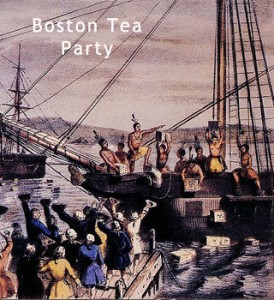 (1773) Boston Tea Party – Colonists threw tea into Boston Harbor in protest of high taxes
(1773) Boston Tea Party – Colonists threw tea into Boston Harbor in protest of high taxes- (1775) First battle of American Revolution fought at Lexington and Concord; Paul Revere made famous ride; first ship of U.S. Navy commissioned
- (1776) British troops forced to evacuate from Boston by Colonial troops; first major victory of American Revolution; Massachusetts resident, John Hancock, first to sign Declaration of Independence
- (1780) John Hancock became first elected governor; state constitution adopted
- (1785) Rebellion of farmers led by Daniel Shay, protested excessive taxation, government systems, unfair treatment of working people
- (1788) Massachusetts became sixth U S. state
- (1796) John Adams, Quincy, became U. S. president
- (1820) Massachusetts and Maine separated
- (1824) John Quincy Adams, of Quincy, elected U. S. President
- (1826) First American railroad built in Quincy
- (1831) The Liberator, anti-slavery newspaper, published in Boston
- (1833) Constitutional amendment separated church and state, Puritanism in government ended
- (1837) Samuel Morse invented Morse Code
- (1839) Charles Goodyear produced first vulcanized rubber in Woburn
- (1840) Typewriter invented by Charles Thurber
- (1845) Elias Howe invented sewing maching in Boston
- (1846) Use of anesthesia surgery first demonstrated by dentist, Dr. William T. G. Morton, at Massachusetts General Hospital
- (1850) First National Women’s Rights Convention held in Worcester
- (1860’s) Massachusetts sent over 160,000 troops to battle in Civil War
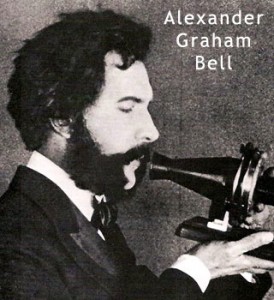 (1876) Alexander Graham Bell demonstrated first telephone in Boston
(1876) Alexander Graham Bell demonstrated first telephone in Boston- (1877) Helen Magill White became first woman in U. S. to earn Ph.D. at Boston University
- (1891) First basketball game played in Springfield; machine invented by James Henry Mitchell mass-produced first Fig Newton Cookies
- (1897) First subway in America opened in Boston
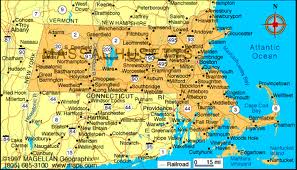 Massachusetts was first colonized by principally English Europeans in the early 17th century, and became the Commonwealth of Massachusetts in the 18th century. Prior toEnglish colonization of the area, it was inhabited by a variety of mainly Algonquian-speaking indigenous tribes. The first permanent English settlement was established in 1620 with the founding of Plymouth Colony by the Pilgrims who sailed on the Mayflower. A second, shorter-lasting colony, was established near Plymouth in 1622 at Wessagusset, now Weymouth. A large Puritan migration begun in 1630 established the Massachusetts Bay Colony and Boston, and spawned the settlement of other New England colonies. Friction with the natives grew with the population, erupting in the Pequot War of the mid-1630s and King Philip’s War in the 1670s. The colonies were religiously conservative, and Massachusetts Bay authorities in particular repeatedly deported, cast out, and even executed people with views that did not accord with their narrow Puritan views. The Massachusetts Bay Colony frequently clashed with political opponents in England, including several kings, over its religious intolerance and the status of its charter. Businessmen established wide-ranging trade links, sending ships to the West Indies and Europe, and sometimes shipping goods in violation of the Navigation Acts. These political and trade issues led to the revocation of the Massachusetts charter in 1684.
Massachusetts was first colonized by principally English Europeans in the early 17th century, and became the Commonwealth of Massachusetts in the 18th century. Prior toEnglish colonization of the area, it was inhabited by a variety of mainly Algonquian-speaking indigenous tribes. The first permanent English settlement was established in 1620 with the founding of Plymouth Colony by the Pilgrims who sailed on the Mayflower. A second, shorter-lasting colony, was established near Plymouth in 1622 at Wessagusset, now Weymouth. A large Puritan migration begun in 1630 established the Massachusetts Bay Colony and Boston, and spawned the settlement of other New England colonies. Friction with the natives grew with the population, erupting in the Pequot War of the mid-1630s and King Philip’s War in the 1670s. The colonies were religiously conservative, and Massachusetts Bay authorities in particular repeatedly deported, cast out, and even executed people with views that did not accord with their narrow Puritan views. The Massachusetts Bay Colony frequently clashed with political opponents in England, including several kings, over its religious intolerance and the status of its charter. Businessmen established wide-ranging trade links, sending ships to the West Indies and Europe, and sometimes shipping goods in violation of the Navigation Acts. These political and trade issues led to the revocation of the Massachusetts charter in 1684.
King James II in 1686 established the Dominion of New England to govern all of New England, whose unpopular rule by Sir Edmund Andros came to a sudden end in 1689 with an uprising sparked by the Glorious Revolution. King William III established the Province of Massachusetts Bay in 1691, to govern a territory roughly equivalent to that of the modern Commonwealth and Maine, although border issues with its neighbors would persist into the 19th century. Its governors were appointed by the crown, in contrast to the predecessor colonies, which had elected their own governors. This created friction between the colonists and the crown, which reached its height in the early days of the American Revolution in the 1760s and 1770s. Massachusetts was where the American Revolutionary War began in 1775, an effort many of its people and businesses supported until Britain formally recognized the United States in 1783.
The commonwealth formally adopted the state constitution in 1780, electing John Hancock its first governor. The state was the first to abolish slavery. In the 19th century the commonwealth became a center of industry, with the development of precision manufacturing and weaponry in Springfield, and large-scale mill complexes in Worcester, Haverhill, and other river communities. The areas around Boston and Springfield became national centers of abolitionist activities, and the Springfield Armory made most of the weaponry for the Union in the American Civil War. After the war, immigrants from Europe flooded into the state, continuing to expand the state’s industrial base well into the 20th century. Labor strife early in the 20th century led to the enaction of labor laws and the rise of unions. Following the Second World War the state’s industrial base began a slow decline, with many textile and manufacturing jobs relocated to states and countries with lower costs of labor. The state’s strength as a center of education contributed to the development of an economy based on information technology and biotechnology in the later years of the 20th century, leading to the “Massachusetts Miracle” of the late 1980s.
‘I shall enter on no encomium upon Massachusetts; she needs none. There she is. Behold her, and judge for yourselves. There is her history; the world knows it by heart. The past, at least, is secure. There is Boston and Concord and Lexington and Bunker Hill; and there they will remain forever.
Before European settlement
Map of southern New England indicating approximate ranges of Native American tribes c. 1600
Massachusetts was originally inhabited by tribes of the Algonquian language family such as the Wampanoag, Narragansett, Nipmuc, Pocomtuc, Mahican, andMassachusett. The Algonquian tribes inhabited the area prior to European settlement. In the Massachusetts Bay area resided the Massachusett people. Near the present Vermont and New Hampshire borders and the Merrimack River valley was the traditional home of the Pennacook tribe. Cape Cod, Nantucket, Martha’s Vineyard, and southeast Massachusetts were the home of the Wampanoag, whom the Pilgrims met. The extreme end of the Cape was inhabited by the closely related Nauset tribe. Much of the central portion and the Connecticut River valley was home to the loosely organized Nipmuc peoples. The Berkshires were the home of both the Pocomtuc and the Mahican tribes. Spillovers of Narragansett and Mohegan from Rhode Island and Connecticut, respectively, were also present.
Although cultivation of crops like squash and corn supplemented their diets, these tribes were generally dependent on hunting, gathering and fishing for most of their food supply. Villages consisted of lodges called wigwams as well as long houses, and tribes were led by male or female elders known as sachems.
In the early 1600s, large numbers of natives were decimated by virgin soil epidemics such as smallpox, measles, influenza, and perhaps leptospirosis, against which they had no immunity. In 1617–1619, smallpox reportedly killed 90% of the Massachusetts Bay Native Americans.[6] The epidemics’ high mortality resulted in extensive restructuring of native politics, with the survivors of previously strong villages banding together to form new alliances – a situation which may have increased their vulnerability during the English invasion.
Europeans began exploring the coast of North America in the 16th century, but few attempts were made at permanent settlement anywhere. Early European explorers of the New England coast included the Englishman Bartholomew Gosnold (who named Cape Cod in 1602), Frenchman Samuel de Champlain (who charted the northern coast as far as Cape Cod in 1605 and 1606), and the Englishmen John Smith and Henry Hudson. Fishing ships from Europe also worked in the fish-rich waters off the coast, and may have engaged in trade with some of the natives.
Europeans: Pilgrims and Puritans: 1620–1629
Mayflower in Plymouth Harbor by William Halsall (1882)
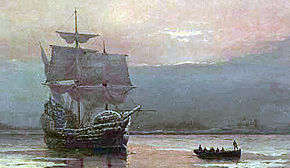 The first English settlers in Massachusetts, the Pilgrims, established their settlement at Plymouth in 1620, and developed friendly relations with the native Wampanoag. This was the second successful permanent English colony in North America, after the Jamestown Colony.
The first English settlers in Massachusetts, the Pilgrims, established their settlement at Plymouth in 1620, and developed friendly relations with the native Wampanoag. This was the second successful permanent English colony in North America, after the Jamestown Colony.
The Pilgrims were from the Humber region of England. Before heading to the New World, they migrated to Holland to avoid persecution. Although they were allowed some religious liberties in Holland, the liberalism and openness of the Dutch to all styles of life horrified them. Once their children grew up Dutch and began adopting the local culture, the Pilgrims decided to leave for the New World.
In the fall of 1619, they sailed to North America on the Mayflower, first landing near the tip of Cape Cod (modern-day Provincetown, Massachusetts). Following exploration along the cape, they established their settlement at Plymouth town in 1620. Since the area was not land that lay within their charter, they created the Mayflower compact, one of America’s first documents of self-governance, prior to landing. The first year was extremely difficult, with inadequate supplies. They also suffered grievously from smallpox and malaria. They were assisted, however, in their time of trouble by the Wampanoag under-chief Massasoit. In 1621, they celebrated their first Thanksgiving Day together to thank God for their survival. Although only about half of the Mayflower company survived the first year, the colony grew slowly over the next ten years, and was estimated to have 300 inhabitants by 1630.
The Plymouth colonists were joined by a colony of adventurers that settled nearby at present-day Weymouth in 1622. This colony was short-lived, and abandoned in 1623, only to be replaced by another small colony led by Robert Gorges. This settlement also failed, and individuals from these colonies either returned to England, joined the Plymouth colonists, or established individual outposts elsewhere on the shores of Massachusetts Bay. In 1624 the Dorchester Company established a settlement on Cape Ann. This colony only survived until 1626, but again a few settlers remained behind. These settlers included Samuel Maverick, David Thompson, and William Blaxton, the latter of whom settled on the Shawmut Peninsula, site of Boston, around that time.
Massachusetts Bay Colony period: 1628–1686
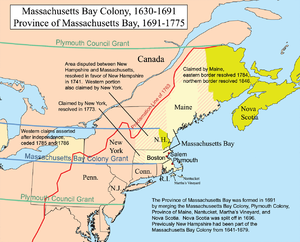 Major boundaries of Massachusetts Bay and neighboring colonial claims in the 17th century and 18th century. Modern state boundaries are partially overlaid for context.
Major boundaries of Massachusetts Bay and neighboring colonial claims in the 17th century and 18th century. Modern state boundaries are partially overlaid for context.
The Pilgrims were followed by Puritans who established the Massachusetts Bay Colony at present-day Salem (1629) and Boston (1630). The Puritans, who believed the Church of England was too hierarchical (among other disagreements) came to Massachusetts for religious freedom, although, like the Plymouth colony, the bay colony was founded under a royal charter. The Puritans were mainly from East Anglia and southwestern regions of England. With an estimated 20,000 migrants between 1628 and 1642, the Massachusetts Bay colony eclipsed Plymouth in population and economy, the chief factors being more suitable harbor facilities for trade and the growth of a prosperous merchant class.
Both religious dissension and expansionism resulted in several new colonies being founded shortly after Plymouth and Massachusetts Bay. Dissenters such as Anne Hutchinson and Roger Williams were banished due to religious disagreements with Massachusetts Bay authorities; (Hutchinson held meetings in her home discussing flaws in the Puritan beliefs, while Williams believed that the Puritan beliefs were wrong, and the Indians must be respected.) In 1636, Williams founded the colony of Rhode Island and Hutchinson joined him there several years later. Others objecting to the religious rule in Massachusetts Bay moved north, joining existing small settlements or establishing new ones in present-day Maine and New Hampshire.
On settling beside the Connecticut River for the first time in 1633 – and for centuries following – Englishmen referred to it simply as “The Great River,” because its length and breadth made English rivers like the Mersey, Thames, and Avon all seem like small streams by comparison. (The Connecticut River is approximately twice as long as England’s Thames.)
In 1636, a group of settlers led by the Massachusetts Bay Colony’s assistant treasurer, William Pynchon founded Springfield, Massachusetts, after first scouting the region’s most advantageous location for trading and farming. To Pynchon’s surprise, it had not yet been settled. “Agawam,” as Springfield was originally called, is located just north of the Connecticut River’s first falls that are unnavigable by sea-going vessels. It also sits amidst the fertile valley that contains New England’s best agricultural land and lies equidistant to the ports of Boston and Albany. Unlike the three settlements south of Springfield at the time – Windsor, Hartford, and Wethersfield, Connecticut – the Natives surrounding Springfield were friendly. In 1640, Pynchon annexed Springfield to the Massachusetts Bay Colony rather than the Connecticut Colony, because he believed that Connecticut’s harsh policies toward the Natives were bad for both business and survival. Thus in 1640, with the annexation of Springfield, the Massachusetts Bay Colony’s southern and western borders were established.
In 1636 all of the New England colonies went to war with the Pequot tribe of southeastern Connecticut, practically wiping them out. In 1646 the Long Parliament gave the missionary John Eliot a commission and funds to preach to the Wampanoags. He succeeded in converting a large number. The colonial government placed the converted Indians (known as Praying Indians) in a ring of villages around Boston as a defensive strategy. The oldest such village, Natick, was built in 1651.
The Puritans came to Massachusetts to establish a society according to their religious principles. They were not tolerant of religious views significantly different from their own. Quakers, Baptists, and other religious Nonconformists were banned, and in 1660 four Quakers were hanged on Boston Common. In addition to the banished Anne Hutchinson and Roger Williams, Thomas Hooker left Massachusetts because of the Puritans’ lack of religious tolerance, founding the Connecticut Colony.
King Philip’s War
Racial tensions led to King Philip’s War (1675–76), the bloodiest Indian war of the early colonial period. There were major campaigns in the Pioneer Valley and Plymouth. Starting in the 1670s, Massachusetts followed the general colonial practice of adopting slave codes, which removed the limitation on the term of slavery for non-whites only. It became fashionable for respectable families to own one or more household slaves as cooks or butlers.
In 1675–76, King Philips War was the single greatest calamity ever to occur in seventeenth-century Puritan New England. In little over a year, nearly half of the region’s towns were attacked – the major settlements at Providence, Rhode Island and Springfield, Massachusetts were both burned to the ground. (See: the Attack on Springfield.) New England’s economy was all but ruined, and much of its population was killed. Proportionately, it was one of the bloodiest and costliest wars in the history of North America.
Economy
Due to persistent shortages of hard currency, the Massachusetts Bay government established a mint, producing a colonial currency, the Massachusetts pound, beginning in 1652.
Following the restoration of Charles II to the throne in 1660, government practices in the colonies came under more scrutiny. The Navigation Acts were passed to regulate trade. Massachusetts, with a thriving merchant fleet, often ran afoul of the trade regulations. Its government was reluctant to enforce them. Combined with intolerant religious practices, and the refusal to allow the Church of England to operate in the colony, led Charles II to formally vacate the Massachusetts charter in 1684.

